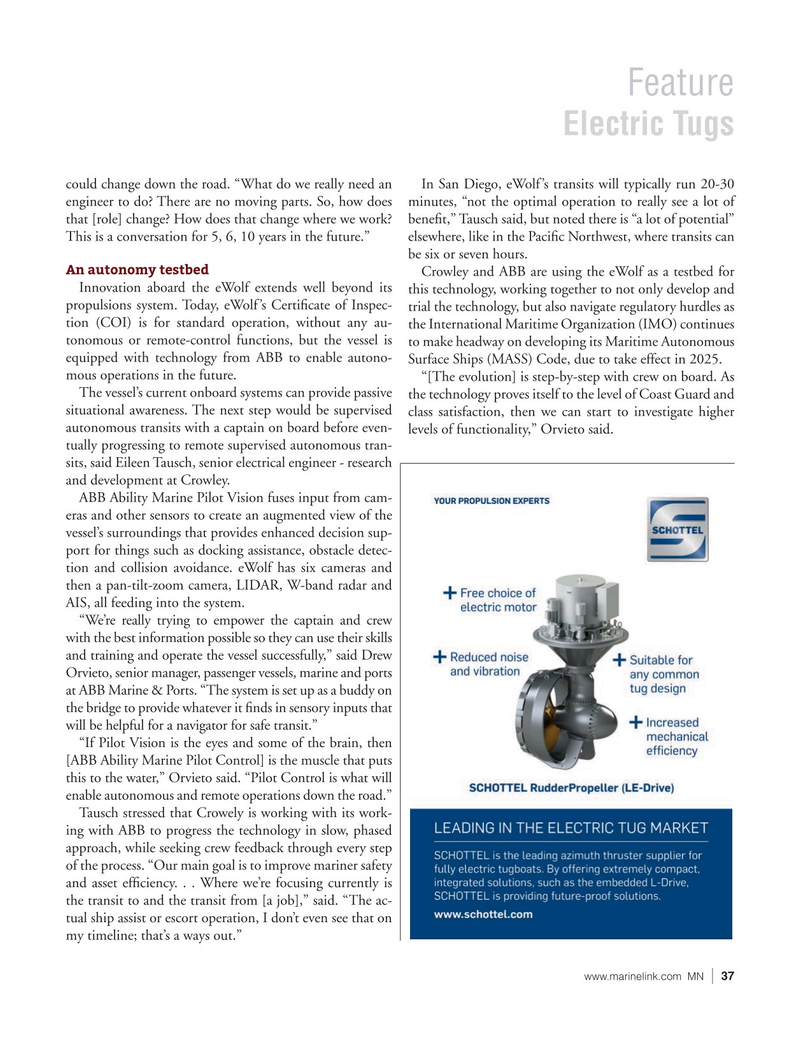
Page 37: of Marine News Magazine (April 2024)
Read this page in Pdf, Flash or Html5 edition of April 2024 Marine News Magazine
Feature
Electric Tugs could change down the road. “What do we really need an In San Diego, eWolf’s transits will typically run 20-30 engineer to do? There are no moving parts. So, how does minutes, “not the optimal operation to really see a lot of that [role] change? How does that change where we work? bene? t,” Tausch said, but noted there is “a lot of potential”
This is a conversation for 5, 6, 10 years in the future.” elsewhere, like in the Paci? c Northwest, where transits can be six or seven hours.
An autonomy testbed
Crowley and ABB are using the eWolf as a testbed for
Innovation aboard the eWolf extends well beyond its this technology, working together to not only develop and propulsions system. Today, eWolf’s Certi? cate of Inspec- trial the technology, but also navigate regulatory hurdles as tion (COI) is for standard operation, without any au- the International Maritime Organization (IMO) continues tonomous or remote-control functions, but the vessel is to make headway on developing its Maritime Autonomous equipped with technology from ABB to enable autono-
Surface Ships (MASS) Code, due to take effect in 2025.
mous operations in the future. “[The evolution] is step-by-step with crew on board. As
The vessel’s current onboard systems can provide passive the technology proves itself to the level of Coast Guard and situational awareness. The next step would be supervised class satisfaction, then we can start to investigate higher autonomous transits with a captain on board before even- levels of functionality,” Orvieto said.
tually progressing to remote supervised autonomous tran- sits, said Eileen Tausch, senior electrical engineer - research and development at Crowley.
ABB Ability Marine Pilot Vision fuses input from cam- eras and other sensors to create an augmented view of the vessel’s surroundings that provides enhanced decision sup- port for things such as docking assistance, obstacle detec- tion and collision avoidance. eWolf has six cameras and then a pan-tilt-zoom camera, LIDAR, W-band radar and
AIS, all feeding into the system.
“We’re really trying to empower the captain and crew with the best information possible so they can use their skills and training and operate the vessel successfully,” said Drew
Orvieto, senior manager, passenger vessels, marine and ports at ABB Marine & Ports. “The system is set up as a buddy on the bridge to provide whatever it ? nds in sensory inputs that will be helpful for a navigator for safe transit.” “If Pilot Vision is the eyes and some of the brain, then [ABB Ability Marine Pilot Control] is the muscle that puts this to the water,” Orvieto said. “Pilot Control is what will enable autonomous and remote operations down the road.”
Tausch stressed that Crowely is working with its work- ing with ABB to progress the technology in slow, phased approach, while seeking crew feedback through every step of the process. “Our main goal is to improve mariner safety and asset ef? ciency. . . Where we’re focusing currently is the transit to and the transit from [a job],” said. “The ac- tual ship assist or escort operation, I don’t even see that on my timeline; that’s a ways out.” www.marinelink.com MN 37|

 36
36

 38
38
